ignition MERCEDES-BENZ M-Class 2014 W166 Owner's Manual
[x] Cancel search | Manufacturer: MERCEDES-BENZ, Model Year: 2014, Model line: M-Class, Model: MERCEDES-BENZ M-Class 2014 W166Pages: 462, PDF Size: 6.23 MB
Page 14 of 462
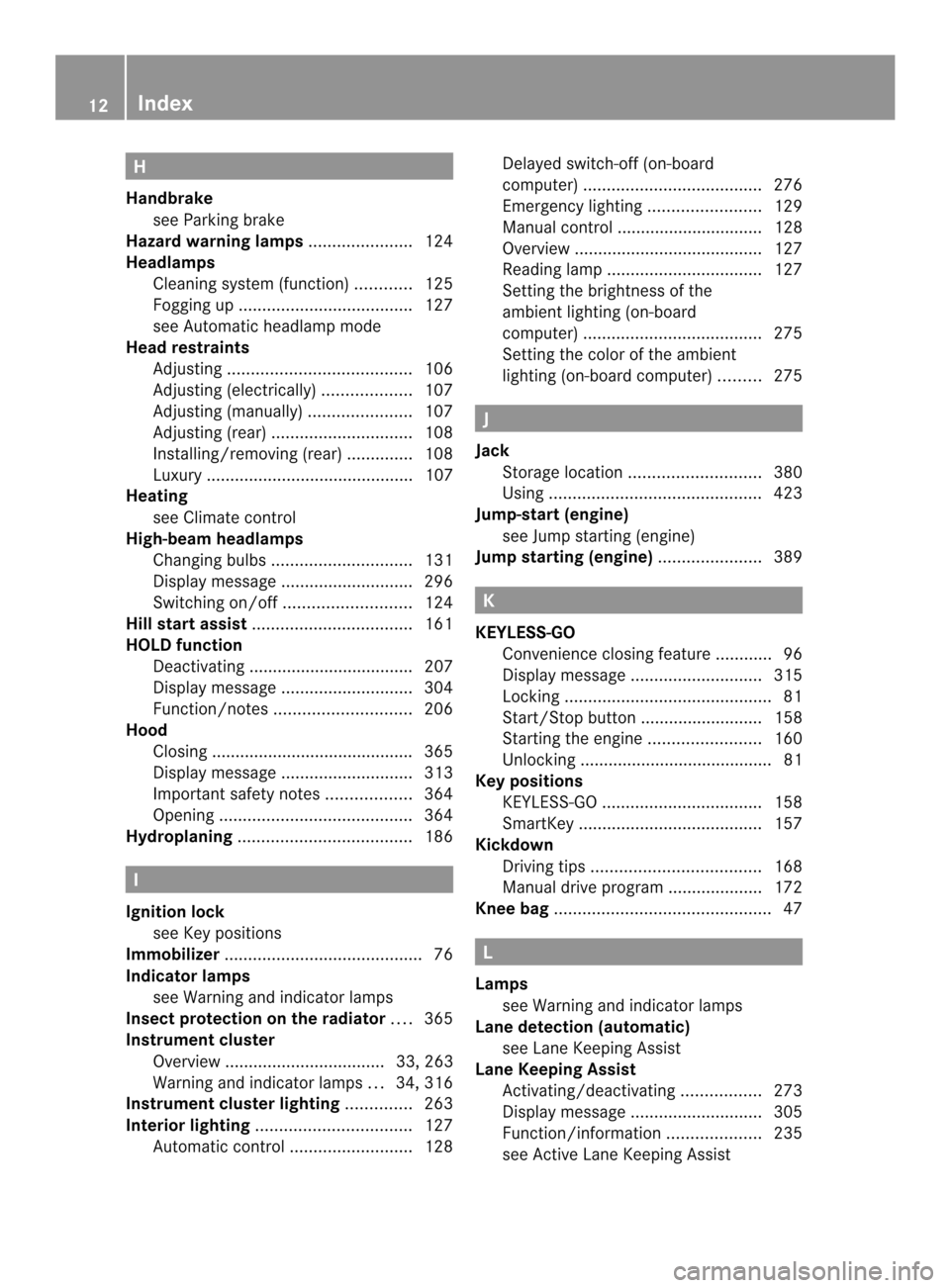
H
Handbrake see Parking brake
Hazard warning lamps ......................124
Headlamps Cleaning system (function) ............125
Fogging up ..................................... 127
see Automatic headlamp mode
Head restraints
Adjusting ....................................... 106
Adjusting (electrically). ..................107
Adjusting (manually). .....................107
Adjusting (rear) .............................. 108
Installing/removing (rear) ..............108
Luxury ............................................ 107
Heating
see Climate control
High-beam headlamps
Changing bulbs .............................. 131
Display message ............................ 296
Switching on/off ........................... 124
Hill start assist .................................. 161
HOLD function Deactivating ................................... 207
Display message ............................ 304
Function/notes ............................. 206
Hood
Closing .......................................... .365
Display message ............................ 313
Important safety notes ..................364
Opening ......................................... 364
Hydroplaning ..................................... 186I
Ignition lock see Key positions
Immobilizer .......................................... 76
Indicator lamps see Warning and indicator lamps
Insectp rotection on the radiator ....365
Instrument cluster Overview .................................. 33, 263
Warning and indicator lamps ...34, 316
Instrument cluster lighting ..............263
Interior lighting ................................. 127
Automatic control ..........................128Delayed switch-off (on-board
computer)
...................................... 276
Emergency lighting ........................129
Manual control ............................... 128
Overview ........................................ 127
Reading lamp ................................. 127
Setting the brightness of the
ambient lighting (on-board
computer) ...................................... 275
Setting the color of the ambient
lighting (on-board computer) .........275 J
Jack Storage location ............................ 380
Using ............................................. 423
Jump-start (engine)
see Jump starting (engine)
Jump starting (engine) ......................389 K
KEYLESS-GO Convenience closing feature ............96
Display message ............................ 315
Locking ............................................ 81
Start/Stop button .......................... 158
Starting the engine ........................160
Unlocking ......................................... 81
Keyp ositions
KEYLESS-GO .................................. 158
SmartKey ....................................... 157
Kickdown
Driving tips .................................... 168
Manual drive program ....................172
Knee bag .............................................. 47 L
Lamps see Warning and indicator lamps
Lane detection (automatic)
see Lane Keeping Assist
Lane Keeping Assist
Activating/deactivating .................273
Display message ............................ 305
Function/informatio n.................... 235
see Active Lane Keeping Assist 12
Index
Page 20 of 462
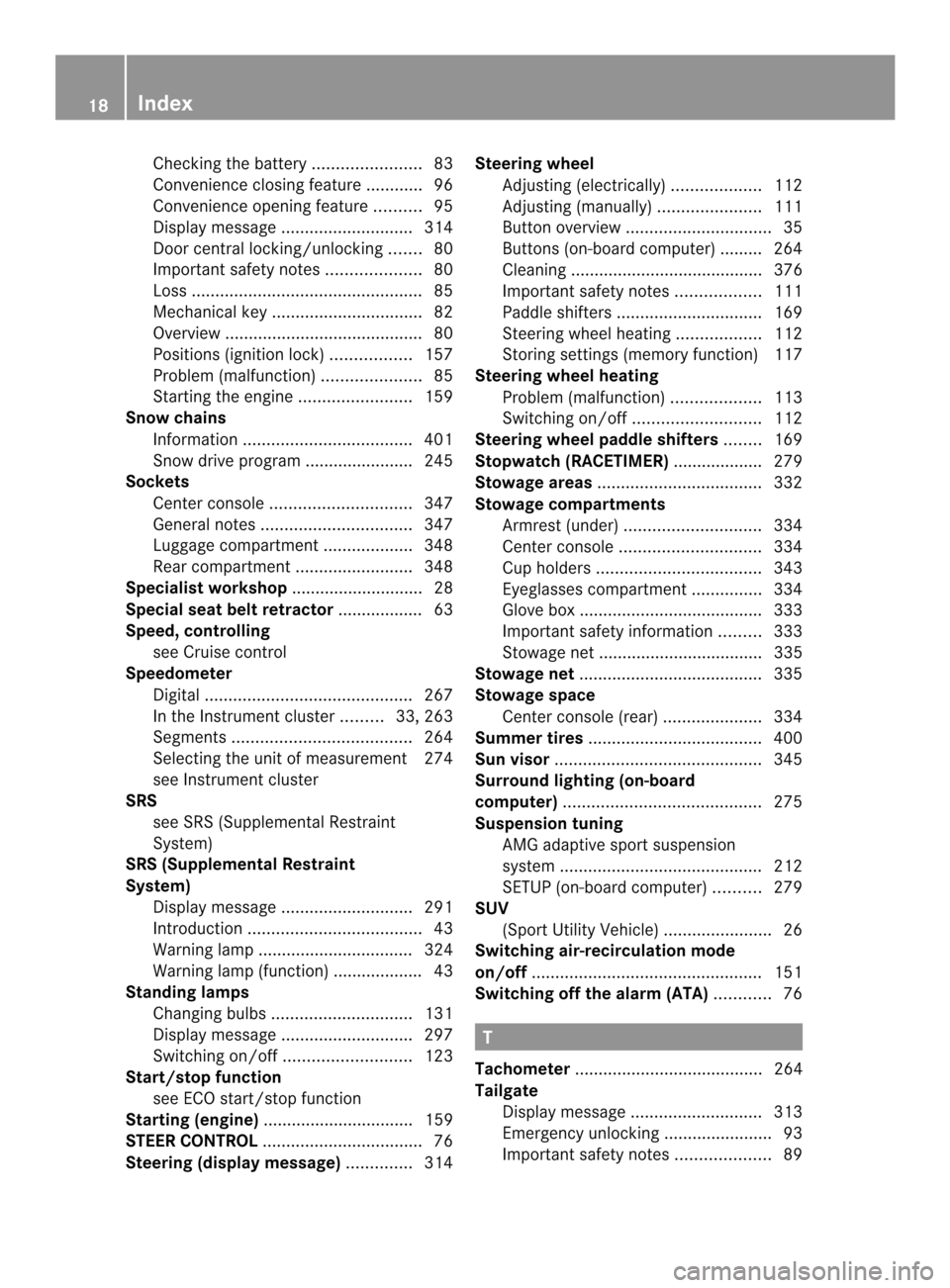
Checkin
gthe battery ....................... 83
Convenience closing feature ............96
Convenience opening feature ..........95
Display message ............................ 314
Door central locking/unlocking .......80
Important safety notes ....................80
Loss ................................................. 85
Mechanical key ................................ 82
Overview .......................................... 80
Positions (ignition lock) .................157
Problem (malfunction) .....................85
Starting the engine ........................159
Snow chains
Information .................................... 401
Snow drive program ....................... 245
Sockets
Center console .............................. 347
General notes ................................ 347
Luggage compartment ...................348
Rea rcompartmen t......................... 348
Specialist workshop ............................ 28
Special seat bel tretractor .................. 63
Speed ,controlling
see Cruise control
Speedometer
Digital ............................................ 267
In the Instrument cluster .........33, 263
Segments ...................................... 264
Selecting the unit of measurement 274
see Instrument cluster
SRS
see SRS (Supplemental Restraint
System)
SRS (Supplemental Restraint
System) Display message ............................ 291
Introduction ..................................... 43
Warning lamp ................................. 324
Warning lamp (function) ................... 43
Standing lamps
Changing bulbs .............................. 131
Display message ............................ 297
Switching on/off ........................... 123
Start/stop function
see ECO start/stop function
Starting (engine) ................................ 159
STEE RCONTROL .................................. 76
Steering (display message) ..............314Steering wheel
Adjusting (electrically). ..................112
Adjusting (manually). .....................111
Button overview ............................... 35
Buttons (on-board computer) ......... 264
Cleaning ......................................... 376
Important safety notes ..................111
Paddle shifters ............................... 169
Steering wheel heating ..................112
Storing settings (memory function) 117
Steering wheel heating
Problem (malfunction) ...................113
Switching on/off ........................... 112
Steering wheel paddle shifters ........169
Stopwatch (RACETIMER) ................... 279
Stowage areas ................................... 332
Stowage compartments Armrest (under) ............................. 334
Center console .............................. 334
Cuph olders ................................... 343
Eyeglasses compartment ...............334
Glove box ...................................... .333
Important safety information .........333
Stowage net ................................... 335
Stowage net ....................................... 335
Stowage space Center console (rear) .....................334
Summer tires ..................................... 400
Sun visor ............................................ 345
Surround lighting (on-board
computer) .......................................... 275
Suspension tuning AMG adaptive sport suspension
system ........................................... 212
SETUP (on-board computer) ..........279
SUV
(Sport Utility Vehicle) .......................26
Switching air-recirculation mode
on/off ................................................. 151
Switching off the alarm (ATA) ............76 T
Tachometer ........................................ 264
Tailgate Display message ............................ 313
Emergency unlocking .......................93
Important safety notes ....................8918
Index
Page 28 of 462
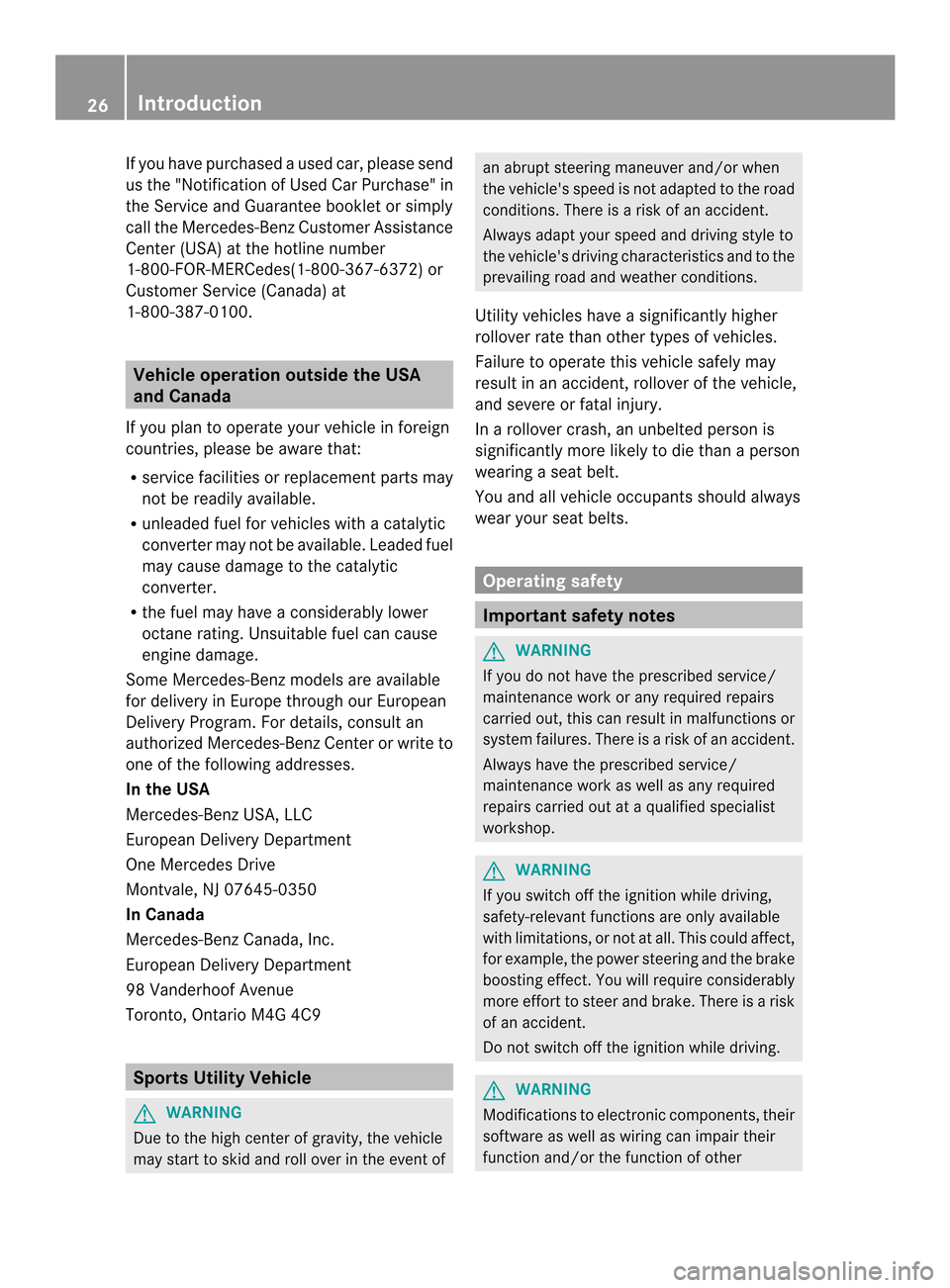
If you have purchased a used car, please send
us the "Notification of Used Car Purchase" in
the Service and Guarantee booklet or simply
call the Mercedes-Benz Customer Assistance
Center (USA) at the hotline number
1-800-FOR-MERCedes(1-800-367-6372) or
Customer Service (Canada) at
1-800-387-0100. Vehicle operation outside the USA
and Canada
If you plant o operate your vehicle in foreign
countries, please be aware that:
R service facilities or replacement parts may
not be readily available.
R unleaded fuel for vehicles with a catalytic
converter may not be available. Leaded fuel
may cause damage to the catalytic
converter.
R the fuel may have a considerably lower
octane rating. Unsuitable fuel can cause
engine damage.
Some Mercedes-Benz models are available
for delivery in Europe through our European
Delivery Program. For details, consult an
authorized Mercedes-Benz Center or write to
one of the following addresses.
In the USA
Mercedes-Benz USA, LLC
European Delivery Department
One Mercedes Drive
Montvale, NJ 07645-0350
In Canada
Mercedes-Benz Canada, Inc.
European Delivery Department
98 Vanderhoof Avenue
Toronto, Ontario M4G 4C9 Sports Utility Vehicle
G
WARNING
Due to the high center of gravity, the vehicle
may start to skid and roll over in the event of an abrupt steering maneuver and/or when
the vehicle's speed is not adapted to the road
conditions. There is a risk of an accident.
Always adapt your speed and driving style to
the vehicle's driving characteristics and to the
prevailing road and weather conditions.
Utility vehicles have a significantly higher
rollover rate than other types of vehicles.
Failure to operate this vehicle safely may
result in an accident, rollover of the vehicle,
and severe or fatal injury.
In a rollover crash, an unbelted person is
significantly more likely to die than a person
wearing a seat belt.
You and all vehicle occupant sshould always
wear your seat belts. Operating safety
Important safety notes
G
WARNING
If you do not have the prescribed service/
maintenance work or any required repairs
carried out, this can result in malfunctions or
system failures. There is a risk of an accident.
Always have the prescribed service/
maintenance work as well as any required
repairs carried out at a qualified specialist
workshop. G
WARNING
If you switch off the ignition while driving,
safety-relevant functions are only available
with limitations, or not at all. This could affect,
for example, the power steering and the brake
boosting effect.Y ou will require considerably
more effort to steer and brake. There is a risk
of an accident.
Do not switch off the ignition while driving. G
WARNING
Modifications to electronic components, their
software as well as wiring can impair their
function and/or the function of other 26
Introduction
Page 34 of 462
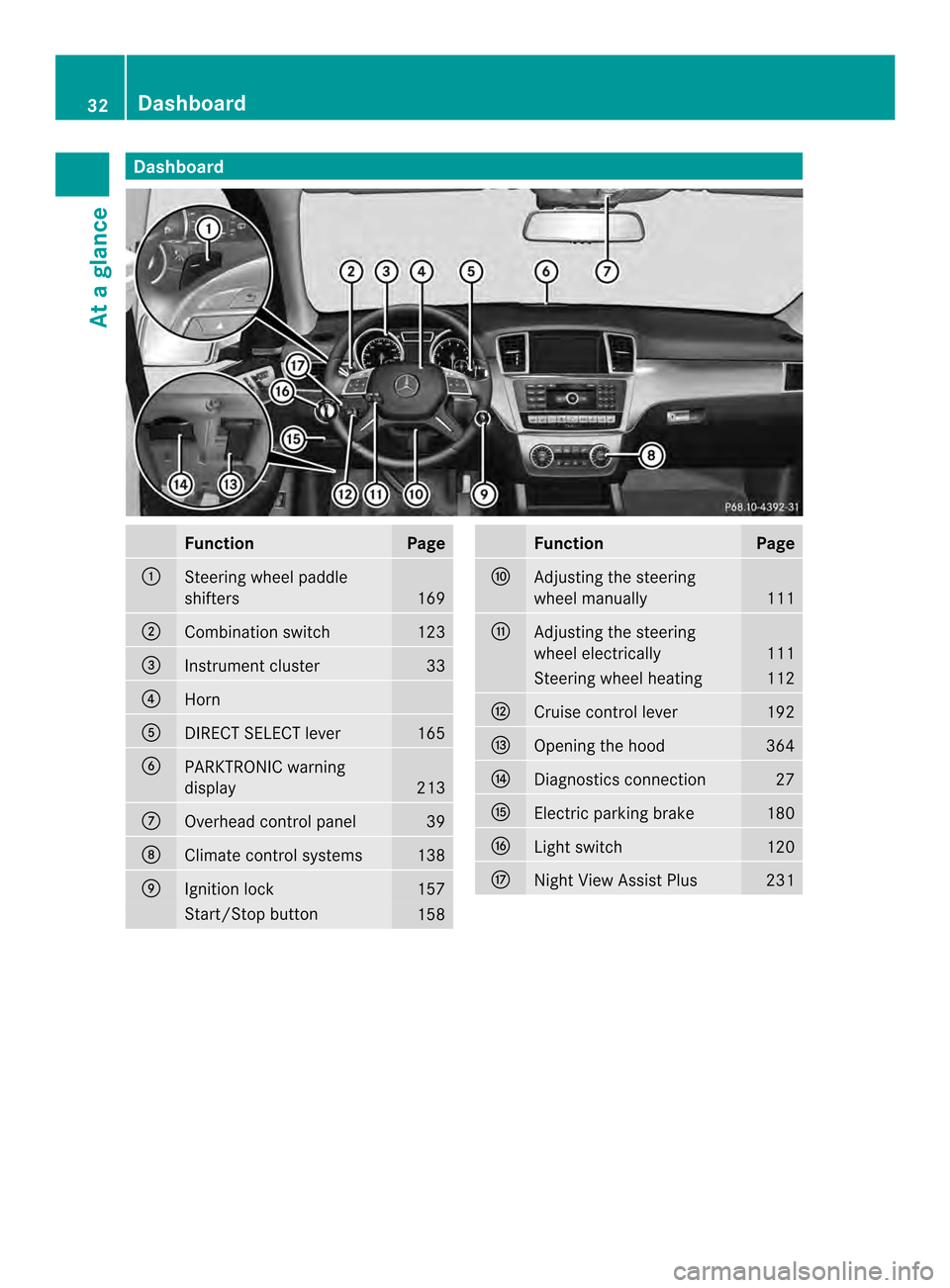
Dashboard
Function Page
0002
Steering wheel paddle
shifters
169
0003
Combination switch 123
0023
Instrument cluster 33
0022
Horn
0020
DIRECT SELECT lever 165
0021
PARKTRONIC warning
display
213
0014
Overhead control panel 39
0015
Climate control systems 138
0016
Ignition lock 157
Start/Stop button
158 Function Page
0017
Adjusting the steering
wheel manually 111
0018
Adjusting the steering
wheel electrically 111
Steering wheel heating 112
001A
Cruise control lever 192
001B
Opening the hood 364
001C
Diagnostics connection 27
001D
Electric parking brake 180
001E
Light switch 120
001F
Night View Assis
tPlus 23132
DashboardAt a glance
Page 44 of 462
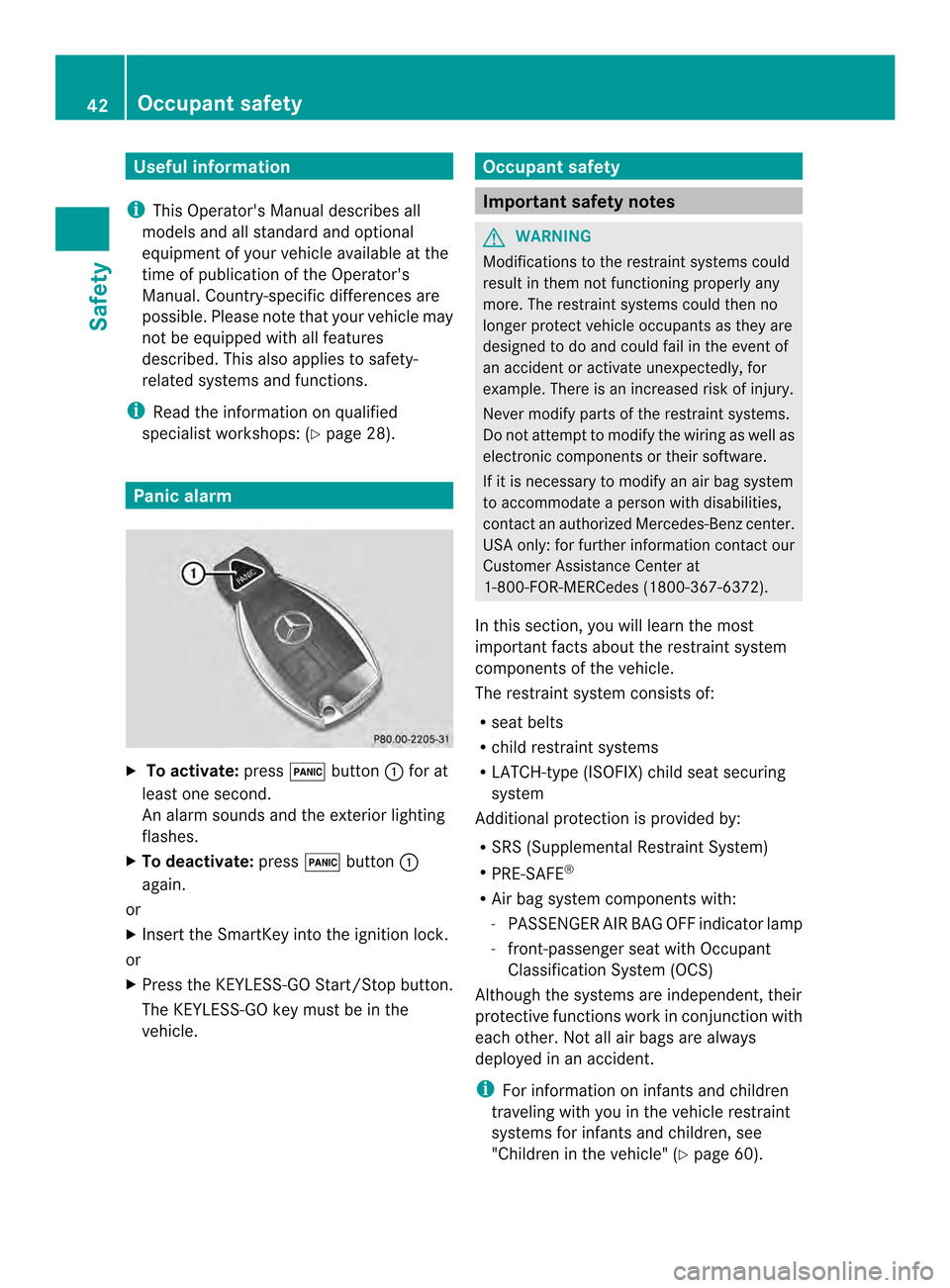
Useful information
i This Operator's Manual describes all
models and all standard and optional
equipment of your vehicle available at the
time of publication of the Operator's
Manual. Country-specific differences are
possible. Please note that your vehicle may
not be equipped with all features
described. This also applies to safety-
related systems and functions.
i Read the information on qualified
specialist workshops: (Y page 28).Panic alarm
X
To activate: press000Dbutton 0002for at
least one second.
An alarm sounds and the exterior lighting
flashes.
X To deactivate: press000Dbutton 0002
again.
or
X Insert the SmartKey into the ignition lock.
or
X Press the KEYLESS-GO Start/Stop button.
The KEYLESS-GO key must be in the
vehicle. Occupant safety
Important safety notes
G
WARNING
Modifications to the restraint systems could
result in them not functioning properly any
more. The restraint systems could then no
longer protect vehicle occupants as they are
designed to do and could fail in the even tof
an accident or activate unexpectedly, for
example. There is an increased risk of injury.
Never modify parts of the restraint systems.
Do no tattemp tto modify the wiring as well as
electronic components or their software.
If it is necessary to modify an air bag system
to accommodate a person with disabilities,
contact an authorized Mercedes-Benz center.
USA only: for further information contact our
Customer Assistance Center at
1-800-FOR-MERCedes (1800-367-6372).
In this section, you will learn the most
important facts about the restraint system
components of the vehicle.
The restraint system consists of:
R seat belts
R child restraint systems
R LATCH-type (ISOFIX) child seat securing
system
Additional protection is provided by:
R SRS (Supplemental Restraint System)
R PRE-SAFE ®
R Air bag system components with:
-PASSENGER AIR BAG OFF indicator lamp
- front-passenger seat with Occupant
Classification System (OCS)
Although the systems are independent, their
protective functions work in conjunction with
each other. Not all air bags are always
deployed in an accident.
i For information on infants and children
traveling with you in the vehicle restraint
systems for infants and children, see
"Children in the vehicle" (Y page 60).42
Occupant safetySafety
Page 45 of 462
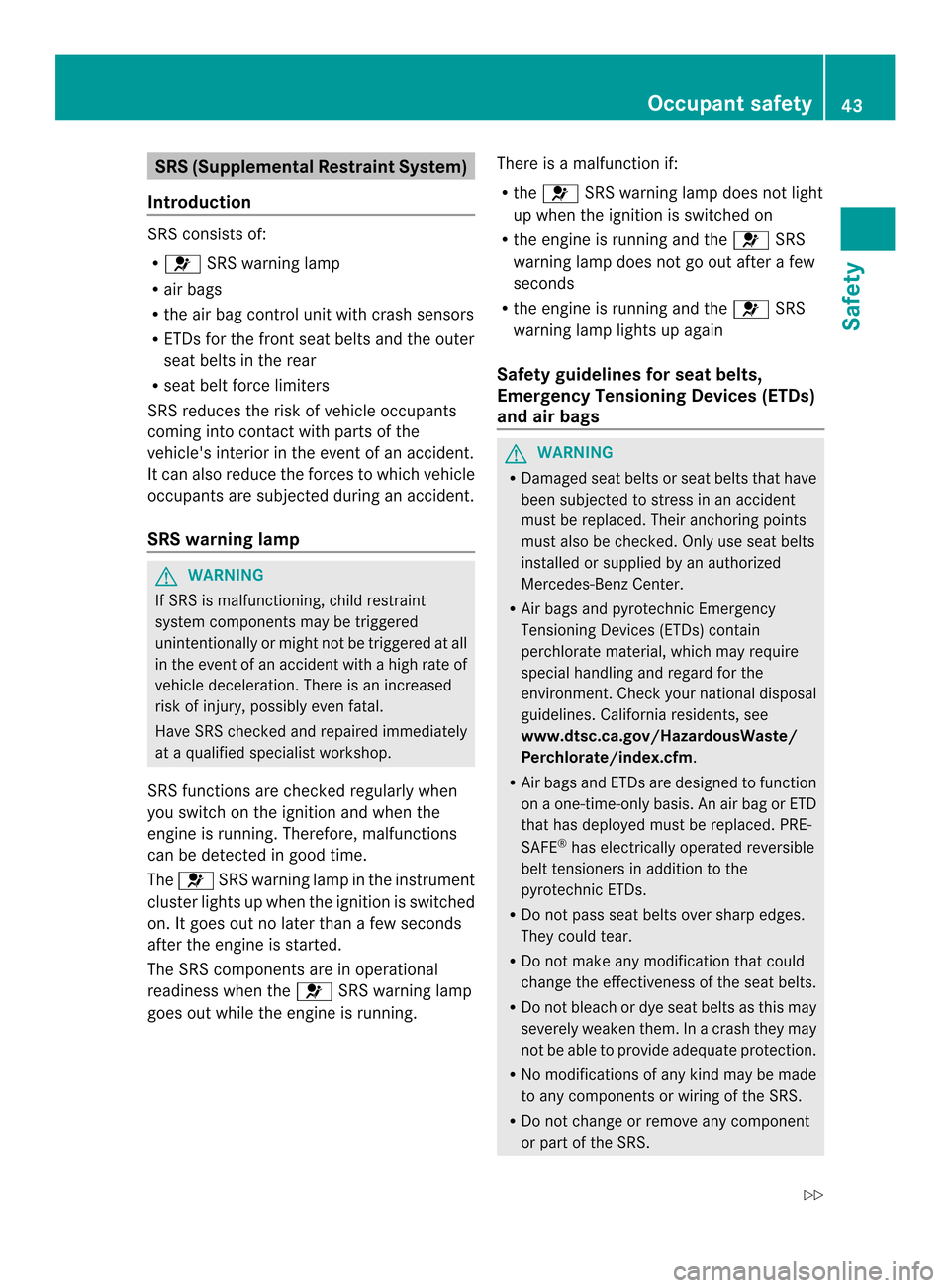
SRS (Supplemental Restraint System)
Introduction SRS consists of:
R
001F SRS warning lamp
R air bags
R the air bag control unit with crash sensors
R ETDs for the front seat belts and the outer
seat belts in the rear
R seat belt force limiters
SRS reduces the risk of vehicle occupants
coming into contact with parts of the
vehicle's interior in the event of an accident.
It can also reduce the forces to which vehicle
occupants are subjected during an accident.
SRS warning lamp G
WARNING
If SRS is malfunctioning, child restraint
system components may be triggered
unintentionally or might not be triggered at all
in the event of an accident with a high rate of
vehicle deceleration. There is an increased
risk of injury, possibly even fatal.
Have SRS checked and repaired immediately
at a qualified specialist workshop.
SRS functions are checked regularly when
you switch on the ignition and when the
engine is running. Therefore, malfunctions
can be detected in good time.
The 001F SRS warning lamp in the instrument
cluster lights up when the ignition is switched
on. It goes out no later than a few seconds
after the engine is started.
The SRS components are in operational
readiness when the 001FSRS warning lamp
goes out while the engine is running. There is a malfunction if:
R
the 001F SRS warning lamp does not light
up when the ignition is switched on
R the engine is running and the 001FSRS
warning lamp does not go out after a few
seconds
R the engine is running and the 001FSRS
warning lamp lights up again
Safety guidelines for seat belts,
Emergency Tensioning Devices (ETDs)
and air bags G
WARNING
R Damaged seat belts or seat belts that have
been subjected to stress in an accident
must be replaced. Their anchoring points
must also be checked. Only use seat belts
installed or supplied by an authorized
Mercedes-Benz Center.
R Air bags and pyrotechnic Emergency
Tensioning Devices (ETDs) contain
perchlorate material, which may require
special handling and regard for the
environment. Check your national disposal
guidelines. California residents, see
www.dtsc.ca.gov/HazardousWaste/
Perchlorate/index.cfm .
R Air bags and ETDs are designed to function
on a one-time-only basis. An air bag or ETD
that has deployed must be replaced. PRE-
SAFE ®
has electrically operated reversible
belt tensioners in addition to the
pyrotechnic ETDs.
R Do not pass seat belts over sharp edges.
They could tear.
R Do not make any modification that could
change the effectiveness of the seat belts.
R Do not bleach or dye seat belts as this may
severely weaken them. In a crash they may
not be able to provide adequate protection.
R No modifications of any kind may be made
to any components or wiring of the SRS.
R Do not change or remove any component
or part of the SRS. Occupant safety
43Safety
Z
Page 53 of 462
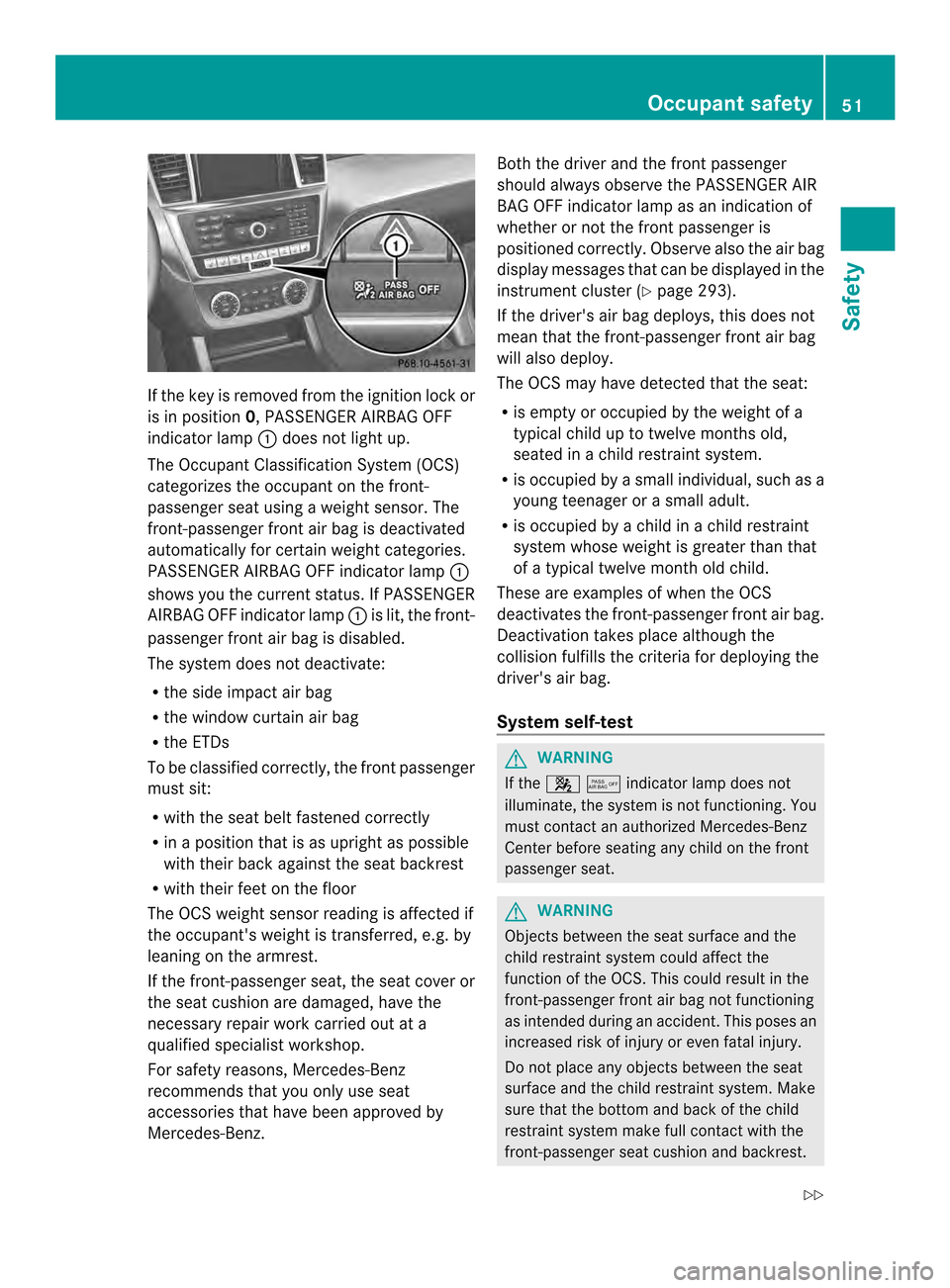
If the key is removed from the ignition lock or
is in position
0, PASSENGER AIRBAG OFF
indicator lamp 0002does not lightu p.
The Occupant Classification System (OCS)
categorizes the occupant on the front-
passenger seat using a weight sensor. The
front-passenger fron tair bag is deactivated
automatically for certain weight categories.
PASSENGER AIRBAG OFF indicator lamp 0002
shows you the current status. If PASSENGER
AIRBAG OFF indicator lamp 0002is lit, the front-
passenger front air bag is disabled.
The system does not deactivate:
R the side impac tair bag
R the window curtain air bag
R the ETDs
To be classified correctly, the front passenger
must sit:
R with the seat belt fastened correctly
R in a position that is as upright as possible
with their back against the seat backrest
R with their feet on the floor
The OCS weight sensor reading is affected if
the occupant's weight is transferred, e.g. by
leaning on the armrest.
If the front-passenger seat, the seat cover or
the seat cushio nare damaged, have the
necessary repair work carried out at a
qualified specialist workshop.
For safety reasons, Mercedes-Benz
recommends that you only use seat
accessories that have been approved by
Mercedes-Benz. Both the drive
rand the front passenger
should always observe the PASSENGER AIR
BAG OFF indicator lamp as an indication of
whethe rornot the front passenger is
positioned correctly. Observe also the air bag
display messages that can be displayed in the
instrument cluster (Y page 293).
If the driver's air bag deploys, this does not
mean that the front-passenger front air bag
will also deploy.
The OCS may have detected that the seat:
R is empty or occupied by the weight of a
typical child up to twelve months old,
seated in a child restraint system.
R is occupied by a small individual, such as a
young teenager or a small adult.
R is occupied by a child in a child restraint
system whose weight is greater than that
of a typical twelve month old child.
These are examples of when the OCS
deactivates the front-passenger front air bag.
Deactivation takes place although the
collision fulfills the criteria for deploying the
driver's air bag.
System self-test G
WARNING
If the 001A001Cindicator lamp does not
illuminate, the system is not functioning. You
must contact an authorized Mercedes-Benz
Center before seating any child on the front
passenger seat. G
WARNING
Objects betwee nthe seat surface and the
child restraint system could affect the
function of the OCS. This could result in the
front-passenger front air bag not functioning
as intended during an accident. This poses an
increased risk of injury or even fatal injury.
Do not place any objectsb etween the seat
surface and the child restraint system. Make
sure that the bottom and back of the child
restraint system make full contact with the
front-passenger seat cushion and backrest. Occupant safety
51Safety
Z
Page 54 of 462
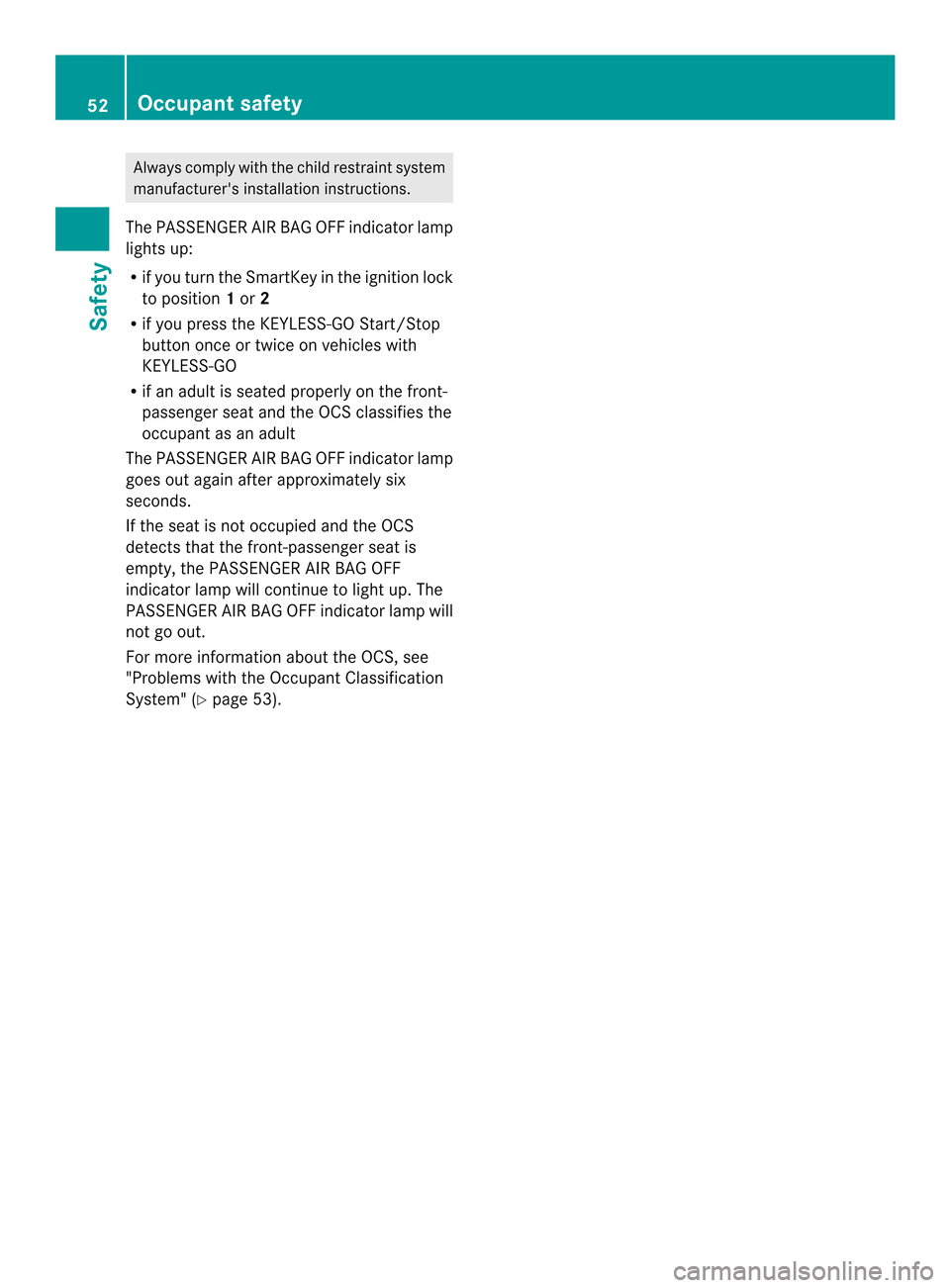
Always comply with the child restraint system
manufacturer's installation instructions.
The PASSENGER AIR BAG OFF indicator lamp
lights up:
R if you turn the SmartKey in the ignition lock
to position 1or 2
R if you press the KEYLESS-GO Start/Stop
button once or twice on vehicles with
KEYLESS-GO
R if an adul tis seated properly on the front-
passenger seat and the OCS classifies the
occupant as an adult
The PASSENGER AIR BAG OFF indicator lamp
goes out againa fter approximately six
seconds.
If the sea tis not occupied and the OCS
detects that the front-passenger seat is
empty, the PASSENGER AIR BAG OFF
indicator lamp will continue to light up. The
PASSENGER AIR BAG OFF indicator lamp will
not go out.
For more information aboutt he OCS, see
"Problems with the Occupant Classification
System" (Y page 53). 52
Occupant safetySafety
Page 59 of 462
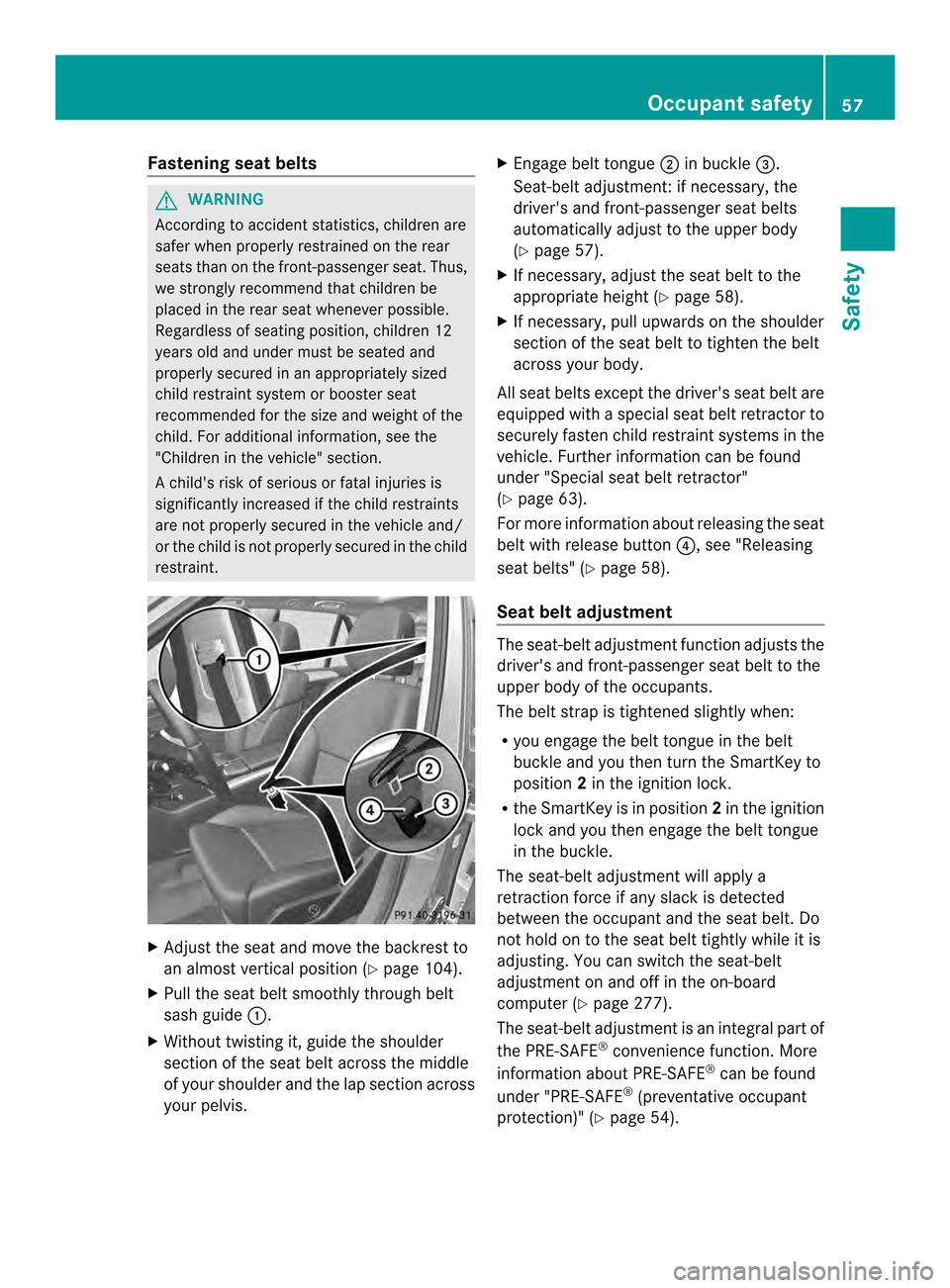
Fastening seat belts
G
WARNING
According to accident statistics, children are
safer when properly restrained on the rear
seats than on the front-passenger seat .Thus,
we strongly recommend that children be
placed in the rear seat whenever possible.
Regardless of seating position, children 12
years old and under must be seated and
properly secured in an appropriately sized
child restraint system or booster seat
recommended for the size and weight of the
child. For additional information, see the
"Children in the vehicle" section.
Ac hild's risk of serious or fatal injuries is
significantly increased if the child restraints
are not properly secured in the vehicle and/
or the child is not properly secured in the child
restraint. X
Adjust the seat and move the backrest to
an almost vertical position (Y page 104).
X Pull the seat belt smoothly through belt
sash guide 0002.
X Without twisting it, guide the shoulder
section of the seat belt across the middle
of your shoulder and the lap section across
your pelvis. X
Engage belt tongue 0003in buckle 0023.
Seat-belt adjustment:ifn ecessary, the
driver's and front-passenger seat belts
automatically adjust to the upper body
(Y page 57).
X If necessary, adjust the seat belt to the
appropriate height (Y page 58).
X If necessary, pull upwards on the shoulder
section of the seat belt to tighten the belt
across your body.
All seat belts except the driver's seat belt are
equipped with a special seat belt retractor to
securely fasten child restraint systems in the
vehicle. Further information can be found
under "Special seat belt retractor"
(Y page 63).
For more information about releasing the seat
belt with release button 0022, see "Releasing
seat belts" (Y page 58).
Seat belt adjustment The seat-belt adjustment function adjusts the
driver's and front-passenger seat belt to the
upper body of the occupants.
The belt strap is tightened slightly when:
R
you engage the belt tongue in the belt
buckle and you then turn the SmartKey to
position 2in the ignition lock.
R the SmartKey is in position 2in the ignition
lock and you then engage the belt tongue
in the buckle.
The seat-belt adjustment will apply a
retraction force if any slack is detected
between the occupant and the seat belt. Do
not hold on to the seat belt tightly while it is
adjusting. You can switch the seat-belt
adjustment on and off in the on-board
computer (Y page 277).
The seat-belt adjustment is an integral part of
the PRE-SAFE ®
convenience function. More
information about PRE-SAFE ®
can be found
under "PRE-SAFE ®
(preventative occupant
protection)" (Y page 54). Occupant safety
57Safety Z
Page 62 of 462
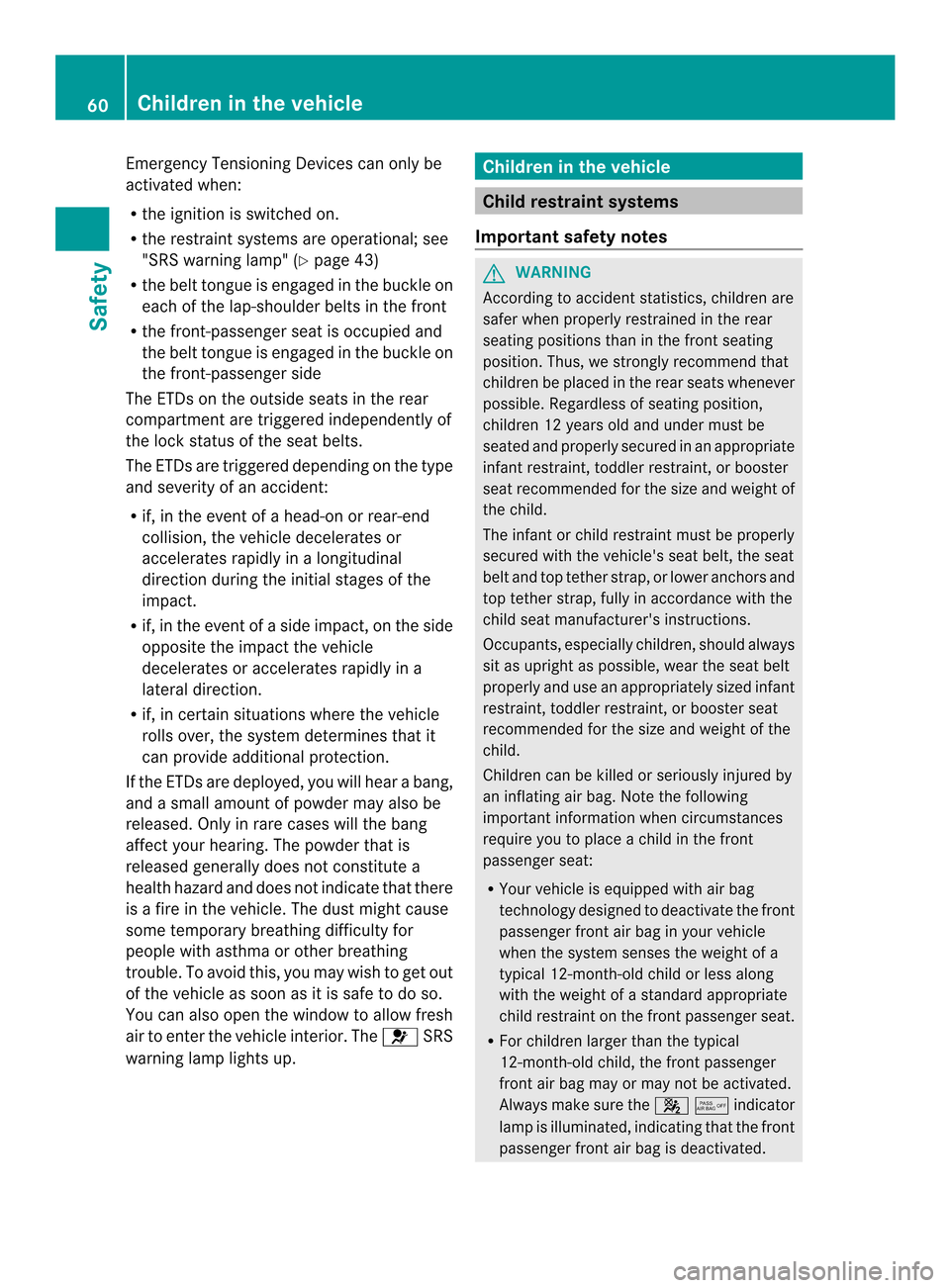
Emergency Tensioning Devices can only be
activated when:
R
the ignition is switched on.
R the restraint systems ar eoperational; see
"SRS warning lamp" (Y page 43)
R the belt tongue is engaged in the buckle on
each of the lap-shoulder belts in the front
R the front-passenger seat is occupied and
the belt tongue is engaged in the buckle on
the front-passenger side
The ETDs on the outside seats in the rear
compartment are triggered independently of
the lock status of the seat belts.
The ETDs are triggered depending on the type
and severity of an accident:
R if, in the event of a head-on or rear-end
collision, the vehicle decelerates or
accelerates rapidly in a longitudinal
direction during the initial stages of the
impact.
R if, in the event of a side impact, on the side
opposite the impact the vehicle
decelerates or accelerates rapidly in a
lateral direction.
R if, in certain situation swhere the vehicle
rolls over, the system determines that it
can provide additional protection.
If the ETDs are deployed, you will hear a bang,
and a small amount of powder may also be
released. Only in rare cases will the bang
affect your hearing. The powder that is
released generally does not constitute a
health hazard and does not indicate that there
is a fire in the vehicle. The dust might cause
some temporary breathing difficulty for
people with asthma or other breathing
trouble. To avoid this, you may wish to get out
of the vehicle as soon as it is safe to do so.
You can also open the window to allow fresh
air to enter the vehicle interior. The 001FSRS
warning lamp lights up. Children in the vehicle
Child restraint systems
Important safety notes G
WARNING
According to accident statistics, children are
safer when properly restrained in the rear
seating positions than in the front seating
position. Thus, we strongly recommend that
children be placed in the rear seats whenever
possible. Regardless of seating position,
children 12 years old and under must be
seated and properly secured in an appropriate
infant restraint, toddler restraint, or booster
seat recommended for the size and weight of
the child.
The infant or child restraint must be properly
secured with the vehicle's seat belt, the seat
belt and top tether strap, or lower anchors and
top tether strap, fully in accordance with the
child seat manufacturer's instructions.
Occupants, especially children, should always
sit as upright as possible, wear the seat belt
properly and use an appropriately sized infant
restraint, toddler restraint, or booster seat
recommended for the size and weight of the
child.
Children can be killed or seriously injured by
an inflating air bag. Note the following
important information when circumstances
require you to place a child in the front
passenger seat:
R Your vehicle is equipped with air bag
technology designed to deactivate the front
passenger front air bag in your vehicle
when the system senses the weight of a
typical 12-month-old child or less along
with the weight of a standard appropriate
child restraint on the front passenger seat.
R For children larger than the typical
12-month-old child, the front passenger
front air bag may or may not be activated.
Always make sure the 001A001Cindicator
lamp is illuminated, indicating that the front
passenger front air bag is deactivated. 60
Children in the vehicleSafety